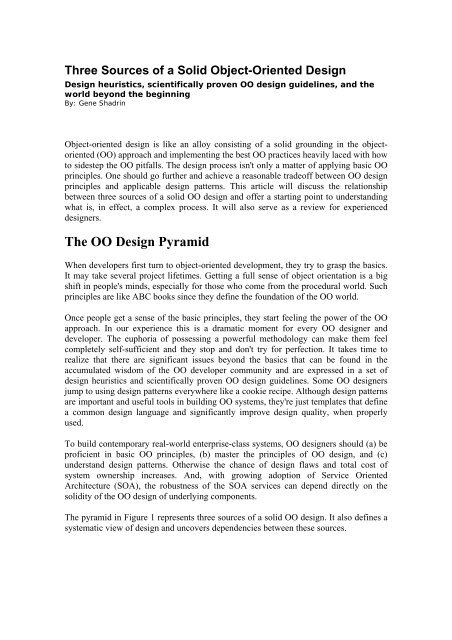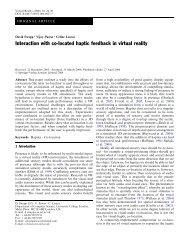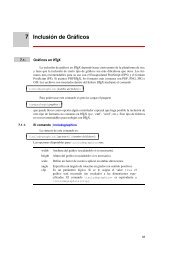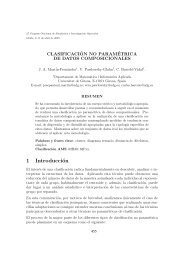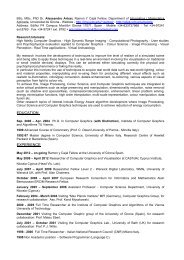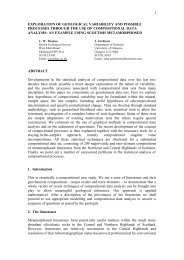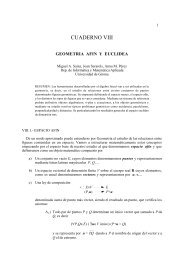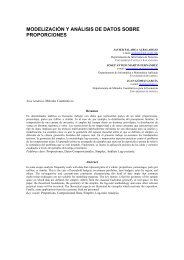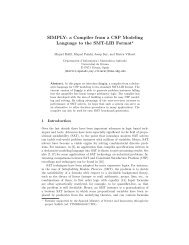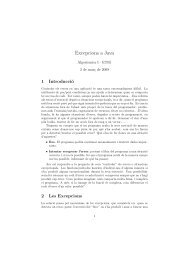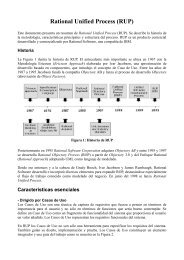The OO Design Pyramid
The OO Design Pyramid
The OO Design Pyramid
- No tags were found...
You also want an ePaper? Increase the reach of your titles
YUMPU automatically turns print PDFs into web optimized ePapers that Google loves.
Now let's discuss each level of this pyramid from an architectural and design point ofview. Of course there's no way to explain these topics completely in such short article,but we'll try to highlight the necessity of paying attention to the dependencies and theirimpact on the quality of <strong>OO</strong> design.Basic <strong>OO</strong> principles<strong>The</strong> first level of the <strong>OO</strong> design pyramid is formed by a set of basic <strong>OO</strong> principles.<strong>The</strong> most basic <strong>OO</strong> principles include encapsulation, inheritance, and polymorphism.Along with abstraction, association, aggregation, and composition, they form thefoundation of the <strong>OO</strong> approach. <strong>The</strong>se basic principles rest on a concept of objects thatdepicts real-world entities such as, say, books, customers, invoices, or birds. <strong>The</strong>seclasses can be considered templates for object instantiation, or object types. In otherwords, class specifies what an object can do (behavior) and defines patterns for its data(state). Modeling the real world in terms of an object's state and behavior is the goal ofthe <strong>OO</strong> approach. In this case, state is represented by a set of object attributes, or data,and behavior is represented by the object's methods.Now we'll discuss the application of basic <strong>OO</strong> principles to modeling.
Encapsulation encloses data and behavior in a programming module. Encapsulation isrepresented by the two close principles of information hiding and implementationhiding. Information hiding restricts access to the object data using a clearly defined"interface" that hides the internal details of the object's structure. For each restrictedclass variable, this interface appears as a pair of "get" and "set" methods that defineread-and-write access to the variable. Implementation hiding defines the accessrestrictions to the object methods also using a clearly defined interface that hides theinternal details of object implementation and exposes only the methods that compriseobject behavior. Both information and implementation hiding serve the main goal -assuring the highest level of decoupling between classes.Inheritance is a relationship that defines one entity in terms of another. It designates theability to create new classes (types) that contain all the methods and properties ofanother class plus additional methods and properties. Inheritance combines interfaceinheritance and implementation inheritance. In this case, interface inheritance describesa new interface in terms of one or more existing interfaces, while implementationinheritance defines a new implementation in terms of one or more existingimplementations. Both interface inheritance and implementation inheritance are used toextend the behavior of a base entity.Polymorphism is the ability of different objects to respond differently to the samemessage. Polymorphism lets a client make the same request of different objects andassume that the operation will be appropriate to each class of object. <strong>The</strong>re are twokinds of polymorphism - inheritance polymorphism, which works on an inheritancechain, and operational polymorphism, which specifies similar operations for non-relatedout-of-inheritance classes or interfaces. Because inheritance polymorphism lets asubclass (subtype) override the operation that it inherits from its superclass (supertype),it creates a way to diversify the behavior of inherited objects in an inheritance chain,while keeping their parent-objects intact. Polymorphism is closely related to inheritanceas well as to encapsulation.Naturally, some <strong>OO</strong> principles are controversial in the sense that they contradict oneanother. For example, to be able to inherit from a class, one should know the internalstructure of that class, while encapsulation's goal is exactly the opposite - it tries to hideas much of the class structure as possible. In real life the tradeoff between these twoprinciples is a fine line that can't be established without stepping up to the next level inthe design pyramid.<strong>OO</strong> <strong>Design</strong> Principles and Heuristics<strong>OO</strong> design principles and heuristics form the second level in <strong>OO</strong> design pyramid.<strong>The</strong>re are about a dozen <strong>OO</strong> design principles and four dozens <strong>OO</strong> design heuristicsidentified over the years by <strong>OO</strong> evangelists such as Grady Booch, Bertrand Meyer,Robert C. Martin, Barbara Liskov, and others. <strong>OO</strong> design principles define the mostcommon scientifically derived approaches for building robust and flexible systems.
<strong>The</strong>se approaches proved to be the best tools in solving numerous <strong>OO</strong> design issues thatcan't be captured by fundamental <strong>OO</strong> principles.<strong>The</strong> class structure and relationships group consists of the following design principles:the Single Responsibility Principle (SRP), the Open/Closed Principle (OCP), the LiskovSubstitution Principle (LSP), the Dependency Inversion Principle (DIP), and theInterface Segregation Principle (ISP).<strong>The</strong> Single Responsibility Principle specifies that class should have only one reason tochange. It's also known as the cohesion principle and dictates that class should haveonly one responsibility, i.e., it should avoid putting together responsibilities that changefor different reasons.<strong>The</strong> Open/Closed Principle dictates that software entities should be open to extensionbut closed to modification. Modules should be written so that they can be extendedwithout being modified. In other words, developers should be able to change what themodules do without changing the modules' source code.<strong>The</strong> Liskov Substitution Principle says that subclasses should be able to substitute fortheir base classes, meaning that clients that use references to base classes must be ableto use the objects of derived classes without knowing them. This principle is essentiallya generalization of a "design by contract" approach that specifies that a polymorphicmethod of a subclass can only replace its pre-condition by a weaker one and its postconditionby a stronger one.Dependency Inversion Principle says high-level modules shouldn't depend on low-levelmodules. In other words, abstractions shouldn't depend on details. Details shoulddepend on abstractions.<strong>The</strong> Interface Segregation Principle says that clients shouldn't depend on the methodsthey don't use. It means multiple client-specific interfaces are better than one generalpurposeinterface.<strong>The</strong> package cohesion group consists of the following design principles: theReuse/Release Equivalency Principle (REP), the Common Closure Principle (CCP), andthe Common Reuse Principle (CRP). This group deals with the principles that definepackaging approaches based on class responsibilities (i.e., how strongly related theresponsibilities of classes are).REP makes release granularity equal to reuse granularity, CCP says classes that changetogether belong together, and CRP says classes that aren't reused jointly shouldn't begrouped together.<strong>The</strong> package coupling group consists of the following design principles: the AcyclicDependency Principle (ADP), the Stable Dependency Principle (SDP), and the StableAbstractions Principle (SAP). This group deals with principles that define packagingapproaches based on the packages' collaboration (i.e., how much one package relies onor is connected to another).
To manage design patterns better and simplify their application to real systems, allpatterns are categorized. Categories reflect the approach to group them together. Forexample, the "Gang of Four" (GoF) patterns generally considered fundamental to allother patterns were categorized by their authors into three groups: Creational,Structural, and Behavioral. Java practitioner Steven John Metsker categorized thesesame patterns into different groups: Interfaces, Responsibility, Construction,Operations, and Extensions.<strong>The</strong> rule of thumb is to try to apply patterns where application design would benefitfrom performance and flexibility. Sometimes, however, designers have to choosepatterns based on just one "benefit." For example, to improve performance, designersshould always apply the core J2EE patterns of Data Access Object, Front Controller,Session Façade, Service Locator, Transfer Object, Transfer Object Assembler, ValueList Handler, and Composite Entity.In most cases, it's possible to come up with appropriate design patterns for particularproblems. Still, there are situations where design patterns either don't exist or offer aninefficient solution. In that case, the solution may rest with design principles andheuristics.Putting It All Together<strong>The</strong> sections above described the content of each <strong>OO</strong> design pyramid level.Interdependencies between pyramid levels are represented by a complex graph thatconfirms their controversial semantics. As seen in Figure 2, which representsrelationships between the first and the second levels (basic <strong>OO</strong> principles and <strong>OO</strong>design principles), some <strong>OO</strong> design principles depend on multiple basic <strong>OO</strong> principleswhile others are drawn based on other considerations.
As such, trying to draw the dependencies in such a graph is impossible. So a moreappropriate methodology would be viewing these design pyramid levels and theirrelationships from the context of their application. Using this methodology, we canrepresent such relationships with this simile. If we take a car engine domain as anexample, then we can think of the basic <strong>OO</strong> principles as the ones defining reciprocalto-rotarymotion conversion principles. This answers the "why" question and explainswhy the system works the way it works.We can think of <strong>OO</strong> design principles and heuristics as answers to the "what" questionbecause they unfold what to do to achieve design harmony. This is similar to the answeron what to do to build an internal-combustion engine.At the top level of the <strong>OO</strong> design pyramid, we find the most effective approaches tosolving generic and specific problems in certain contexts. We can think of this level asthe one answering the "where" question. It's like picking the most efficient engineconstructions for particular consumer requirements.So different levels of the <strong>OO</strong> design pyramid tackle different aspects of <strong>OO</strong> design.Experience shows that one can't leave any of them out without running the risk ofloosing something important. Applying the elements from the upper levels withoutaligning them to the lower levels can lead to design flaws, while applying elementsfrom the lower levels without knowing the upper levels can increase design time(potentially at a lower quality), since designers would be forced to "reinvent the wheel"(see Figure 3).
ConclusionBecause <strong>OO</strong> design elements focus on different aspects of <strong>OO</strong> design, coupled withtheir controversial and generic nature, knowing or even mastering only one or twolevels of the <strong>OO</strong> design pyramid isn't enough to develop contemporary, robust, flexible,extensible, and stable software. <strong>OO</strong> designers and developers have to take all levels ofthe pyramid into account and apply them in a systematic manner.Applying <strong>OO</strong> design levels in a top-down approach (from design patterns to designprinciples and heuristics to basic <strong>OO</strong> principles) saves design time and increases designquality by ensuring that none of the important dependencies are lost.References• Thinking in Java, Third Edition by Bruce Eckel, Prentice Hall PTR, 2002, ISBN:0131002872• Agile Software Development, Principles, Patterns, and Practices by Robert CecilMartin, Prentice Hall, 2002, ISBN: 0135974445• Object-Oriented <strong>Design</strong> Heuristics by Arthur J. Riel, Addison-Wesley Professional,1996, ISBN: 020163385X• <strong>Design</strong> Patterns by Erich Gamma, Richard Helm, Ralph Johnson, John Vlissides,Addison-Wesley Professional, 1995, ISBN: 0201633612• <strong>Design</strong> Patterns Java Workbook by Steven John Metsker, Addison-Wesley Pub Co,2002, ISBN: 0201743973• Core J2EE Patterns: Best Practices and <strong>Design</strong> Strategies, Second Edition byDeepak Alur, Dan Malks, John Crupi, Prentice Hall PTR, 2003, ISBN: 0131422464• Patterns of Enterprise Application Architecture by Martin Fowler, David Rice,Matthew Foemmel, Edward Hieatt, Robert Mee, Randy Stafford, Addison-WesleyProfessional, 2002, ISBN: 0321127420• www.objectsbydesign.com/tools/umltools_byCompany.html for a list of design tools.


